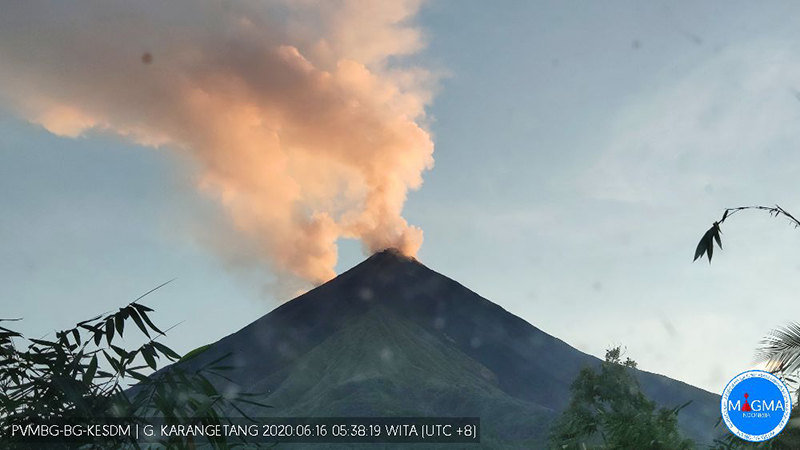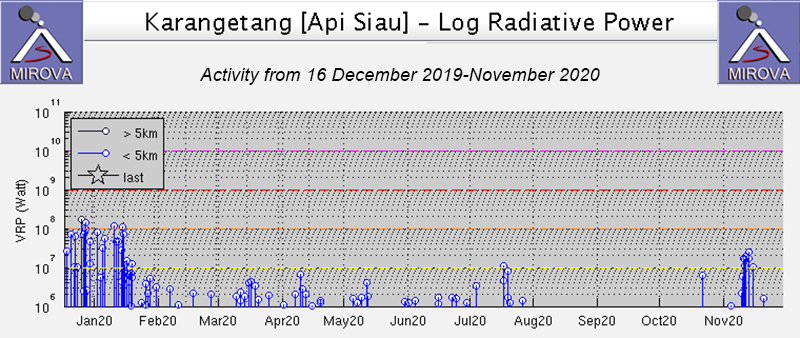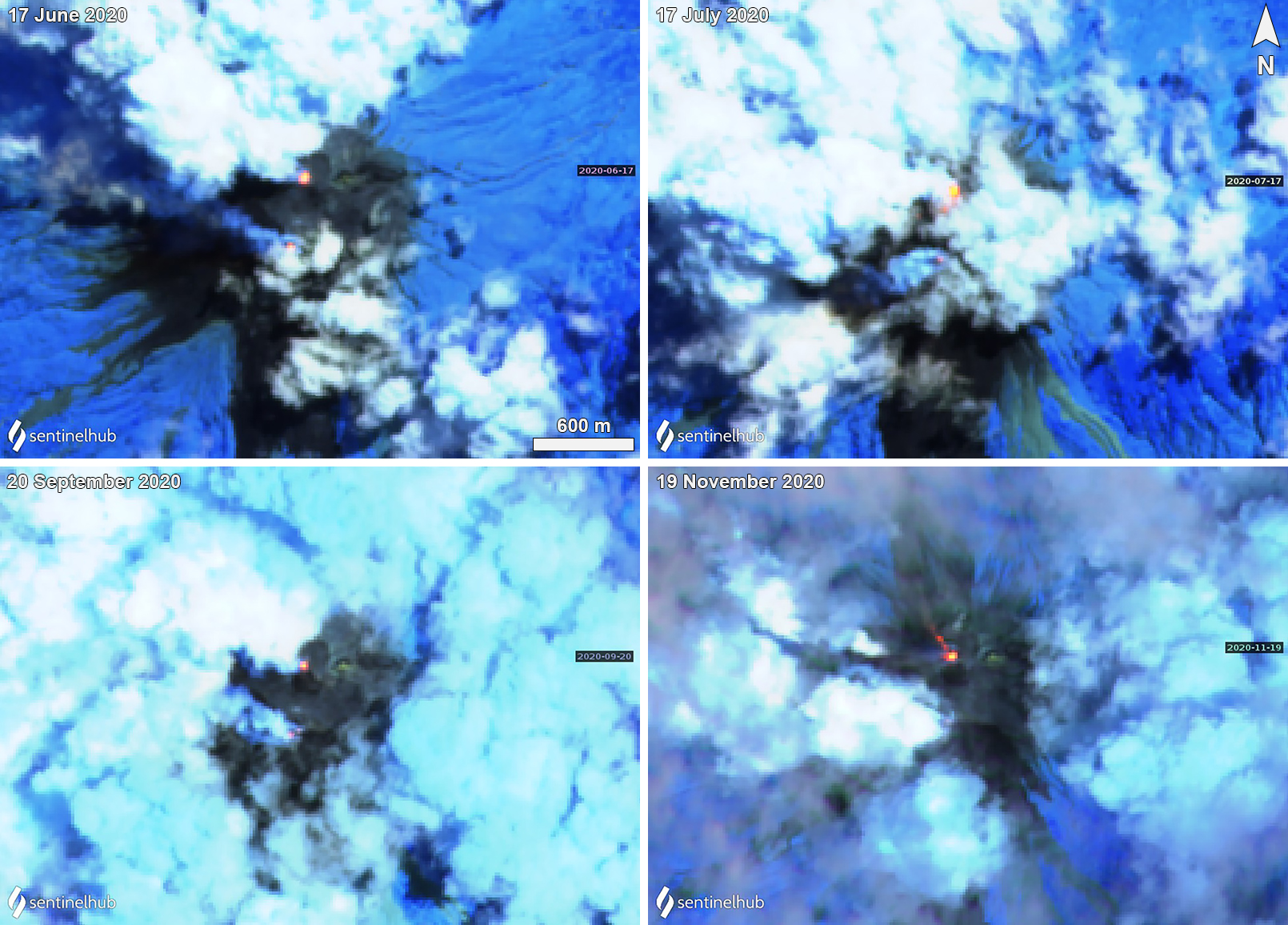Report on Karangetang (Indonesia) — December 2020
Bulletin of the Global Volcanism Network, vol. 45, no. 12 (December 2020)
Managing Editor: Edward Venzke.
Edited by Kadie L. Bennis.
Karangetang (Indonesia) Hot material on the NW flank in November 2020; intermittent crater thermal anomalies
Please cite this report as:
Global Volcanism Program, 2020. Report on Karangetang (Indonesia) (Bennis, K.L., and Venzke, E., eds.). Bulletin of the Global Volcanism Network, 45:12. Smithsonian Institution. https://doi.org/10.5479/si.GVP.BGVN202012-267020
Karangetang
Indonesia
2.781°N, 125.407°E; summit elev. 1797 m
All times are local (unless otherwise noted)
Karangetang (also known as Api Siau) is located on the island of Siau in the Sitaro Regency, North Sulawesi, Indonesia and consists of two active summit craters: a N crater (Kawah Dua) and a S crater (Kawah Utama, also referred to as the “Main Crater”). More than 50 eruptions have been observed since 1675. The current eruption began in November 2018 and has recently been characterized by frequent incandescent block avalanches, thermal anomalies in the crater, and gas-and-steam plumes (BGVN 45:06). This report covers activity from June through November 2020, which includes dominantly crater anomalies, few ash plumes, and gas-and-steam emissions. Information primarily comes from the Pusat Vulkanologi dan Mitigasi Bencana Geologi (PVMBG, also known as CVGHM, or the Center of Volcanology and Geological Hazard Mitigation), MAGMA Indonesia, and various satellite data.
Activity decreased significantly after mid-January 2020 and has been characterized by dominantly gas-and-steam emissions and occasional ash plumes, according to PVMBG. Daily gas-and-steam emissions were observed rising 25-600 m above the Main Crater (S crater) during the reporting period and intermittent emissions rising 25-300 m above Kawah Dua (N crater).
The only activity reported by PVMBG in June, August, and October was daily gas-and-steam emissions above the Main Crater and Kawah Dua (figure 47). MIROVA (Middle InfraRed Observation of Volcanic Activity) analysis of MODIS satellite data shows intermittent low-power thermal anomalies during June through late July, which includes a slight increase in power during late July (figure 48). During 14-15 July strong rumbling from Kawah Dua was accompanied by white-gray emissions that rose 150-200 m above the crater. Crater incandescence was observed up to 10 m above the crater. According to webcam imagery from MAGMA Indonesia, intermittent incandescence was observed at night from both craters through 25 July. In a Volcano Observatory Notice for Aviation (VONA) issued on 5 September, PVMBG reported an ash plume that rose 800 m above the crater.
 |
Figure 47. Webcam image of gas-and-steam plumes rising above the two summit craters at Karangetang on 16 June 2020. Courtesy of MAGMA Indonesia. |
Thermal activity increased briefly during mid-November when hot material was reported extending 500-1,000 m NW of the Main Crater, accompanied by gas-and-steam emissions rising 200 m above the crater. Corresponding detection of MODIS thermal anomalies was seen in MIROVA graphs (see figure 48), and the MODVOLC system showed alerts on 13 and 15 November. On 16 November blue emissions were observed above the Main Crater drifting W. Sentinel-2 thermal images showed elevated temperatures in both summit craters throughout the reporting period, accompanied by gas-and-steam emissions and movement of hot material on the NW flank on 19 November (figure 49). White gas-and-steam emissions rose to a maximum height of 300 m above Kawah Dua on 22 November and 600 m above the Main Crater on 28 November.
Geological Summary. Karangetang (Api Siau) volcano lies at the northern end of the island of Siau, about 125 km NNE of the NE-most point of Sulawesi. The stratovolcano contains five summit craters along a N-S line. It is one of Indonesia's most active volcanoes, with more than 40 eruptions recorded since 1675 and many additional small eruptions that were not documented (Neumann van Padang, 1951). Twentieth-century eruptions have included frequent explosive activity sometimes accompanied by pyroclastic flows and lahars. Lava dome growth has occurred in the summit craters; collapse of lava flow fronts have produced pyroclastic flows.
Information Contacts: Pusat Vulkanologi dan Mitigasi Bencana Geologi (PVMBG, also known as Indonesian Center for Volcanology and Geological Hazard Mitigation, CVGHM), Jalan Diponegoro 57, Bandung 40122, Indonesia (URL: http://www.vsi.esdm.go.id/); MAGMA Indonesia, Kementerian Energi dan Sumber Daya Mineral (URL: https://magma.vsi.esdm.go.id/); MIROVA (Middle InfraRed Observation of Volcanic Activity), a collaborative project between the Universities of Turin and Florence (Italy) supported by the Centre for Volcanic Risk of the Italian Civil Protection Department (URL: http://www.mirovaweb.it/); Hawai'i Institute of Geophysics and Planetology (HIGP) - MODVOLC Thermal Alerts System, School of Ocean and Earth Science and Technology (SOEST), Univ. of Hawai'i, 2525 Correa Road, Honolulu, HI 96822, USA (URL: http://modis.higp.hawaii.edu/); Sentinel Hub Playground (URL: https://www.sentinel-hub.com/explore/sentinel-playground).



